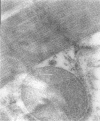The role of nitric oxide in Doxorubicin-induced cardiotoxicity: experimental study
- PMID: 24764732
- PMCID: PMC3996644
- DOI: 10.4274/Tjh.2013.0013
The role of nitric oxide in Doxorubicin-induced cardiotoxicity: experimental study
Abstract
Objective: We evaluated the myocardial damage in rats treated with doxorubicin (DOX) alone and in combination with nitric oxide synthase (NOS) inhibitors.
Materials and methods: Twenty-four male Sprague Dawley rats (12 weeks old, weighing 262±18 g) were randomly assigned into 4 groups (n=6). Group I was the control group. In Group II, rats were treated with intraperitoneal (ip) injections of 3 mg/kg DOX once a week for 5 weeks. In Group III, rats received weekly ip injections of 30 mg/kg L-NAME (nonspecific NOS inhibitor) 30 min before DOX injections for 5 weeks. In Group IV, rats received weekly ip injections of 3 mg/kg L-NIL (inducible NOS inhibitor) 30 min before DOX injections for 5 weeks. Rats were weighed 2 times a week. At the end of 6 weeks, hearts were excised and then fixed for light and electron microscopy evaluation and tissue lipid peroxidation (malondialdehyde). Blood samples were also obtained for measuring plasma lipid peroxidation.
Results: Weight loss was observed in Group II, Group III, and Group IV. Weight loss was statistically significant in the DOX group. Findings of myocardial damage were significantly higher in animals treated with DOX only than in the control group. Histopathological findings of cardiotoxicity in rats treated with DOX in combination with L-NAME and L-NIL were not significantly different compared with the control group. The level of plasma malondialdehyde in the DOX group (9.3±3.4 µmol/L) was higher than those of all other groups.
Conclusion: Our results showed that DOX cardiotoxicity was significantly decreased when DOX was given with NO synthase inhibitors.
Amaç: Bu çalışmada sıçanlarda doksorubisinin (DOX) tek başına ve nitrik oksit sentaz (NOS) inhibitörleri ile birlikte kullanımının kalp kası üzerinde yarattığı hasar araştırıldı.Gereç ve Yöntemler: Çalışmada 12 haftalık 24 adet erkek “Sprague Dawley” sıçanı (ortalama ağırlık 262±18 gr) rastgele dört gruba (n=6) dağıtıldı. Grup I kontrol grubu olarak ayırıldı. Grup II’ye haftada bir kez intraperitoneal (ip) 3 mg/kg, beş hafta DOX uygulandı. Grup III’e DOX enjeksiyonundan 30 dakika önce ip 30 mg/kg L-NAME (nonselektif NOS inhibitörü) 5 hafta uygulandı. Grup IV’e DOX enjeksiyonundan 30 dakika önce ip 3 mg/kg L-NIL (indüklenebilir NOS inhibitörü) 5 hafta uygulandı. Çalışma süresince sıçanlar haftada iki kez tartıldı. Altıncı haftada kalbin sol ventrikülünden alınan parçalardan elektron ve ışık mikroskobik inceleme ve lipit peroksidasyonu tayini (malondialdehid) yapıldı. Plazma lipit peroksidasyonunun belirlenmesi amacı ile sıçanlardan kan alındı.Bulgular: Grup II, Grup III ve Grup IV’te kilo kaybı gözlendi. DOX uygulanan grupta istatistiksel olarak anlamlı kilo kaybı saptandı. Miyokard hasarı bulguları tek başına DOX alan hayvanlarda kontrol grubuna oranla daha yüksek oranda izlendi. DOX’le beraber L-NAME ve L-NIL verilen sıçanlarda kardiyotoksitenin histopatolojik bulguları kontrol grubundan farklı değildi. Plazma malondialdehid düzeyi DOX grubunda (9,3± 3,4), diğer tüm gruplara göre daha yüksek olarak ölçüldü. Sonuç: Bizim çalışmamızda DOX’la beraber NOS inhibitörleri uygulandığında DOX’a bağlı kardiyak toksisite bulgularında anlamlı azalma olduğu gösterilmiştir.
Keywords: Doxorubicin; Nitric oxide synthase inhibitors; nitric oxide.
Figures




Similar articles
-
Effect of gemfibrozil on cardiotoxicity induced by doxorubicin in male experimental rats.Biomed Pharmacother. 2019 Jan;109:530-535. doi: 10.1016/j.biopha.2018.10.101. Epub 2018 Nov 6. Biomed Pharmacother. 2019. PMID: 30551518
-
Potent metalloporphyrin peroxynitrite decomposition catalyst protects against the development of doxorubicin-induced cardiac dysfunction.Circulation. 2003 Feb 18;107(6):896-904. doi: 10.1161/01.cir.0000048192.52098.dd. Circulation. 2003. PMID: 12591762
-
Effect of Shengmai injection () on diaphragmatic contractility in doxorubicin-treated rats.Chin J Integr Med. 2014 Jan;20(1):43-8. doi: 10.1007/s11655-012-1096-9. Epub 2012 Aug 18. Chin J Integr Med. 2014. PMID: 22903440
-
Differential roles of nitric oxide synthase isozymes in cardiotoxicity and mortality following chronic doxorubicin treatment in mice.Naunyn Schmiedebergs Arch Pharmacol. 2009 Jul;380(1):25-34. doi: 10.1007/s00210-009-0407-y. Epub 2009 Mar 24. Naunyn Schmiedebergs Arch Pharmacol. 2009. PMID: 19308358 Free PMC article.
-
Doxorubicin-induced nitrosative stress is mitigated by vitamin C via the modulation of nitric oxide synthases.Am J Physiol Cell Physiol. 2017 Apr 1;312(4):C418-C427. doi: 10.1152/ajpcell.00356.2016. Epub 2017 Jan 18. Am J Physiol Cell Physiol. 2017. PMID: 28100487
Cited by
-
Coenzyme Q10 protects against doxorubicin-induced cardiomyopathy via antioxidant and anti-apoptotic pathway.Tissue Barriers. 2023 Jan 2;11(1):2019504. doi: 10.1080/21688370.2021.2019504. Epub 2021 Dec 23. Tissue Barriers. 2023. PMID: 34939895 Free PMC article.
-
Identifying metabolic adaptations characteristic of cardiotoxicity using paired transcriptomics and metabolomics data integrated with a computational model of heart metabolism.PLoS Comput Biol. 2024 Feb 29;20(2):e1011919. doi: 10.1371/journal.pcbi.1011919. eCollection 2024 Feb. PLoS Comput Biol. 2024. PMID: 38422168 Free PMC article.
-
Self-Assembled Maslinic Acid Attenuates Doxorobucin Induced Cytotoxicity via Nrf2 Signaling Pathway: An In Vitro and In Silico Study in Human Healthy Cells.Cell Biochem Biophys. 2022 Sep;80(3):563-578. doi: 10.1007/s12013-022-01083-3. Epub 2022 Jul 18. Cell Biochem Biophys. 2022. PMID: 35849306
-
Oxidative stress and inflammation: determinants of anthracycline cardiotoxicity and possible therapeutic targets.Heart Fail Rev. 2021 Jul;26(4):881-890. doi: 10.1007/s10741-020-10063-9. Epub 2020 Dec 15. Heart Fail Rev. 2021. PMID: 33319255 Free PMC article. Review.
-
Doxorubicin-Induced Cardiotoxicity: An Overview on Pre-clinical Therapeutic Approaches.Cardiovasc Toxicol. 2022 Apr;22(4):292-310. doi: 10.1007/s12012-022-09721-1. Epub 2022 Jan 21. Cardiovasc Toxicol. 2022. PMID: 35061218 Review.
References
-
- Minotti G, Menna P, Salvatorelli E, Cairo G, Gianni L. Anthracyclines: molecular advances and pharmacologic developments in antitumor activity and cardiotoxicity. Pharmocol Rev. 2004;56:185–229. - PubMed
-
- Paulides M, Kremers A, Stöhr W, Bielack S, Jürgens H, Treuner J, Beck JD. Prospective longitudinal evaluation of doxorubicin-induced cardiomyopathy in sarcoma patients: a report of the late effects surveillance system (LESS) Pediatr Blood Cancer. 2006;46:489–495. - PubMed
-
- Kremer LC, Dalen EC, van, Offringa M, Ottenkamp J, Voûte PA. Anthracycline-induced clinical heart failure in a cohort of 607 children: long-term follow-up study. J Clin Oncol. 2001;19:191–196. - PubMed
-
- Doroshow JH. Effect of anthracycline antibiotics on oxygen radical formation in rat heart. Cancer Res. 1983;43:460–472. - PubMed
-
- Keizer HG, Pinedo HM, Schuurhuis GJ, Joenje H. Doxorubicin (adriamycin): a critical review of free radical-dependent mechanisms of cytotoxicity. Pharmacol Ther. 1990;47:219–231. - PubMed
LinkOut - more resources
Full Text Sources
Other Literature Sources
